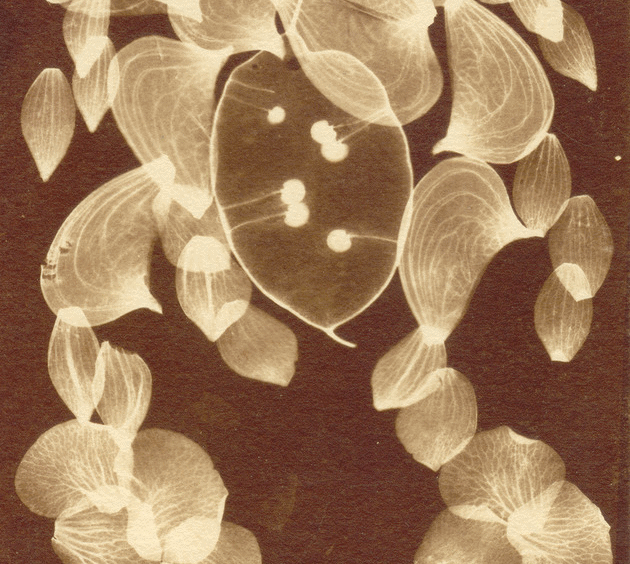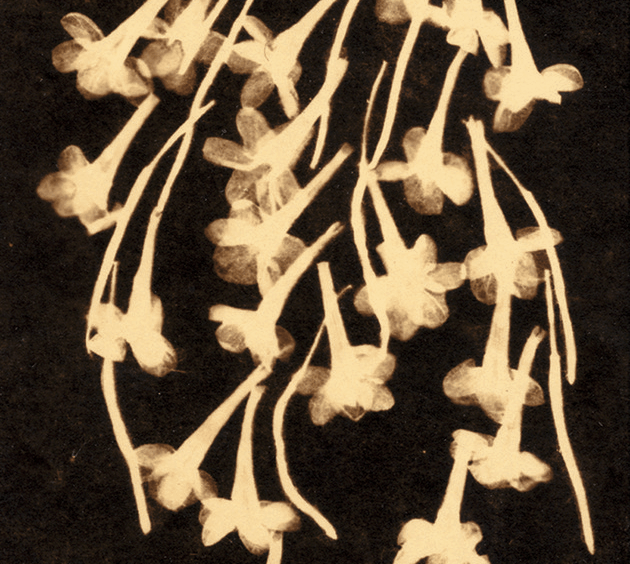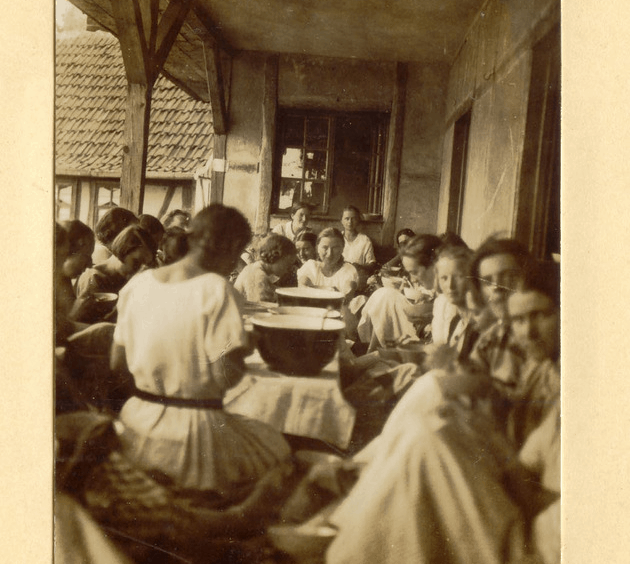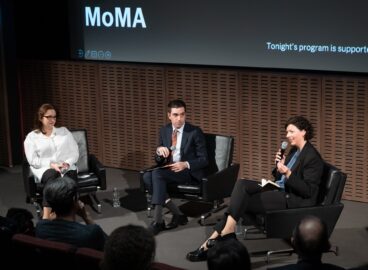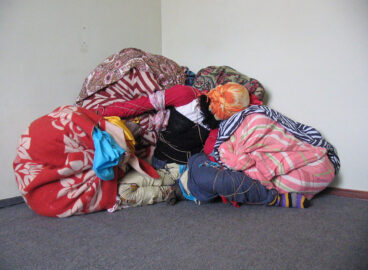Exactly one century ago, Walter Gropius established the now famous Bauhaus in Weimar, Germany, but few know that only 100 miles away another center of utopian artistry and intellectualism opened that same year, with one key difference: all of the students were women. Madeline Weisburg reports from the field on the radical pedagogy of Loheland, which maintained as a central objective the creation of a space for women to combine art, movement, work, leisure and learning. This text introduces one student in particular, Bertha Günther, who created a body of photograms from 1920 to 1922 that served as inspiration to László Moholy-Nagy and Lucia Moholy, who visited the school on several occasions prior to their arrival at the Bauhaus.

It had just started to snow when I arrived at Loheland last spring, although it was mid-April and forsythia blooms were already dotting the woodland compound. Nestled into the foothills of the Rhön in central Germany, near the small town of Fulda, the woodland compound, once an art school for women, overlooks a flat expanse of farmland on one side, and the forest on the other. Transposed against the soft curves and steeply pitched roofs of mossy, elfin buildings, some constructed as early as 1919, the weather only served to heighten the almost comically picturesque scene before me. It was not hard to imagine the four women who, pictured in a late 1920s photomontage, are jumping in unison in white skirts, on the very same lawn before me. Nor was it hard to imagine Bertha Günther—an early Loheland student whose photograms made from leaves, plants, and petals would be some of the first László Moholy-Nagy would see prior to his own experiments—gathering her materials in this very remote place a century ago.




2019 marks the centennial of the Bauhaus, a cause for celebration throughout both Germany and much farther afield, including here at The Museum of Modern Art. Although it is widely known that this radical testing ground of modernism was established in Weimar by Walter Gropius in 1919, few are aware that just one hundred miles away, another experimental center of utopian artistry and intellectualism opened that same year, but with one key difference: all of its students were women. Founded by Louise Langgaard and Hedwig von Rohden on a fifty-four-acre plot of undeveloped arable land, the Loheland Schule für Körperbildung, Landbau und Handwerk (Loheland School for Physical Education, Agriculture and Crafts) set out to educate a “new generation of women.”1See Iris Fischer and Eckhardt Köhn, eds., Lichtbildwerkstatt Loheland: Fotografien, 1919–1939, Vonderau Museum Fulda 11 (Petersberg: Imhof in association with Vonderau Museum Fulda, 2004), 7. Its students would not only receive vocational training that would enable them to make a living, but through a type of separatism, would also ostensibly be liberated from the conservative, bourgeois culture in which most of them had been raised. Anticipating Loheland’s future motto, in 1911 Langgaard would surmise, “I have in mind a new type of female artist, namely women who are calmly and confidently at peace with themselves.”2Quoted in “What Does the New Woman Need? 100 Years of Loheland Colony,” Bauhaus 100, https://www.bauhaus100.com/magazine/discover-the-bauhaus/what-does-the-new-woman-need/. In September, in celebration of the school’s hundredth anniversary, the Vonderau Museum in Fulda, in partnership with the Loheland Foundation, will present Loheland: Lived Visions for a New World, curated by Michael Siebenbrodt in cooperation with Elisabeth Mollenhauer-Klüber of the Loheland Archive.
Today, Loheland is home to a Waldorf school, but most of its original buildings, such as the 1924–25 sandstone Evahaus, which is named for the expressionist dancer Eva Maria Deinhardt, still stand. Deinhardt, a model Lohelander who was frequently photographed in various states of rhythmic intensity, was known for her woodcuts, beekeeping, and pedagogy, in addition to her athleticism.3Elisabeth Mollenhauer-Klüber, conversation with author, April 13, 2019. The remarkable Waggonia, a cluster of four train cars acquired through the Prussian State Railway and retrofitted in 1926 to serve as tailoring and leather workshops, residential dwellings for composers of the community, and the Lichtbildwerkstatt Loheland (Loheland photography workshop), is also still intact. In its heyday, under the direction of Valerie Wizlsperger, the workshop disseminated promotional images throughout Germany via postcards and print advertisements depicting Loheland architecture, women running and throwing spears in the mountains, vegetables in various stages of development, wooden cabinetry, and clusters of dancers wearing handmade costumes.





Like the Bauhaus in Weimar, Loheland’s mission was to provide a holistic education, in which students engaged in physical exercises, sensory training, and self-exploration alongside craft and design. These teachings would mirror the process-over-product philosophy of Johannes Itten, the bald and monkish Bauhaus master who began workshop sessions with yogic exercises, including rhythmic chants.4For information on Itten and spiritualism at the Weimar Bauhaus in relation to Loheland see, for example, two chapters in the recently published volume Bauhaus Bodies: Gender, Sexuality, and Body Culture in Modernism’s Legendary Art School: Ute Ackermann, “‘Bodies Drilled in Freedom’: Nudity, Body Culture, and Classic Gymnastics at the Early Bauhaus,” and Linn Burchert, “The Spiritual Enhancement of the Body: Johannes Itten, Gertrud Grunow, and Mazdaznan at the Early Bauhaus,” in Bauhaus Bodies: Gender, Sexuality, and Body Culture in Modernism’s Legendary Art School, eds. Elizabeth Otto and Patrick Rössler, Visual Cultures and German Contexts (New York: Bloomsbury Visual Arts, Bloomsbury Publishing, 2019), 25–48, 49–72. In 1919, Gropius wrote to von Rohden, “What you are doing is so perfectly in tune with our inner structure that I very much want the Bauhaus to come in contact with you.”5Walter Gropius to Hedwig von Rohden, 3 November 1919, Thüringisches Hauptstaatsarchiv, Staaliches Bauhaus, no. 28. Quoted in Sandra Neugärtner, “Utopias of a New Society: Lucia Moholy, László Moholy-Nagy, and the Loheland and Schwarzerden Women’s Communes,” in Bauhaus Bodies, eds. Otto and Rössler, 77. Furthermore, Loheland was well-known for expressionist dance, a practice with which Bauhaus affiliates would have been familiar. Tänze der Loheländer performances took place in 1916 and 1920 in Weimar, one of which was offered to an exclusively Bauhaus audience. For more information, see Elisabeth Mollenhauer-Klüber and Michael Siebenbrodt, eds., Bauhaus-Parallelen: Loheland-Werkstätten (Weimar: Freundeskreis der Bauhaus-Universität; Künzell: Loheland-Stiftung, 2012), 22.
Established under the influence of anthroposophy, an occultist philosophy developed by Rudolf Steiner, and the emergent Lebensreform (Life reform) movement, which ushered in a swell of collectivist pedagogical experiments throughout Germany, Loheland promoted a philosophy of interdisciplinarity in which the applied arts in concert with spiritualism and alternative forms of everyday living were seen as a balm to industrialization and the increasing fracturing of the social collective. Langgaard had been a member of the Anthroposophical Society since 1913 and graduated from the Dresden School of Arts and Crafts as a drawing teacher; von Rohden had been involved in the counterculture youth movement Wandervogel, which in addition to heralding a back-to-the-land ethos, sought forms of community outside of the patriarchal structure; and both women were part of the Association for Classical Gymnastics, which abetted the increasingly popular field of gymnastics.6For information about the role of gymnastics in the Lebensreform movement, see Karl Eric Toepfer, Empire of Ecstasy: Nudity and Movement in German Body Culture, 1910–1935, Weimar and Now: German Cultural Criticism (Berkeley: University of California Press, 1997). For more on the Bauhaus’s and Loheland’s philosophies of movement, see Oliver Botar, “The Biocentric Bauhaus,” in The Routledge Companion to Biology in Art and Architecture, eds. Charissa N. Terranova and Meredith Tromble, Routledge Companions (New York: Routledge, 2017), 13–51.
Considered an accessible form of expression for women, in which they were freed from the constraints of the corset, gymnastics in tandem with expressive dance had fast become a component in the repertoire for modern living—an uptick not inconsequentially linked to the fact that the job of gymnastics instructor was one of the first in which women could gain professional certification.7Ackermann, “Bodies Drilled in Freedom,” 25. When Loheland opened, movement training formed the backbone of its curriculum. Yet this conceit was twofold: although the founders maintained that the rhythmic movements and melodramatic poses of what would be dubbed Tänze der Loheländer (Lohelander’s Dances) were knowledge producing, and integral to the effort to “disentangle [students’] creative abilities”8Hedwig von Rohden and Louise Langgaard, “Über Bewegung,” Gymnastik 5/6 (May 1928): n.p. —that is, to promote self-actualization—this training also provided students with teaching certifications in gymnastics and thus was a means to future employment opportunities. As the enterprise quickly expanded to institute a curriculum in which classical gymnastics and expressionist dance were combined with biodynamic farming and workshops in weaving, woodworking, leatherworking, pottery, and photography, this pedagogical philosophy would extend even further. These workshops, too, served the same dual function: the goals were to learn and know everything, to create a type of mental circuitry connecting nature, experimentation, and process as a defining counterpart to aesthetics—but they included providing women with a trade and thus the chance to be part of public economic life.9Fischer and Köhn, Lichtbildwerkstatt Loheland, 32. Loheland women, for example, frequently participated in craft fairs in Germany, where they sold their goods.


The faculty of Loheland understood, possibly earlier than that of the Bauhaus, the role that photography could play in pushing forward pedagogical and economic missions. While the Bauhaus in Dessau waited until 1929 to open an official photography department, Loheland consecrated the Lichtbildwerkstatt Loheland(Loheland photography workshop) in 1926, although engagement with the medium had begun much earlier.10See ibid., 24–27. From the very beginning of Loheland’s history, dance photography, in particular, was an essential part of the pedagogical project. By 1917, while preparing to open the school, von Rohden was said to have asserted that in order to attract the attention of important people, “pictures” had to be used.11Ibid., 25. Accordingly, photographs of Loheland dancers in futuristic costumes, their muscles contorted in sensual, affected postures, could be found throughout the German media during the institution’s early days,12Ibid., 8–9. while Valerie Wizlsperger’s still life photographs of arranged wooden buttons and tight close-ups of brocade exemplified the spirit of the burgeoning field of modern advertising in the illustrated press. Within the corpus of existing literature on women’s engagement with photography at the Bauhaus, as well as the relationship between the “New Woman” and photography in Weimar Germany more generally, the camera has been understood as an “instrument of self-determination”—both an example of women participating in public life, as well as a vehicle that allowed for critique of recent shifts in gender roles.13See Ute Eskildsen, “A Chance to Participate: A Transitional Time for Women Photographers,” in Visions of the “Neue Frau”: Women and the Visual Arts in Weimar Germany, eds. Marsha Meskimmon and Shearer West (Aldershot, UK: Scolar Press; Brookfield, VT: Ashgate Publishing Company, 1995), 62–76. Yet, within the scope of the Loheland project and its orientation toward holistic interconnectivity, one gets the sense that the process of generating photographic images played a part that was equal in importance to their dissemination. What’s more, the very nature of the school’s intensely utopian isolationist strategy challenges an easy reading of photography as simply self-promotional. At Loheland, photography was both inward and outward—for it enabled a type of self-determination at the fringe.



This can be seen in the work of Bertha Günther, a largely unknown figure who between 1920 and 1922 created a body of delicate small-format photograms composed of local plant life. In the summer of 1922, before their arrival at the Bauhaus, László Moholy-Nagy and Lucia Moholy, while on holiday in the nearby town of Weyhers, visited Loheland. Deep in their discussions about the ideas that would soon constitute “Production-Reproduction,” for which Lucia Moholy would receive no credit, Moholy-Nagy would later write that on this trip he learned of the photogram technique in part through a “Loheländerin” who “reinvigorated a generally overlooked process of placing objects on photographic paper and thus creating shadows.”14See László Moholy-Nagy, “Die Photographie in der Reklame,” Photographische Korrespondenz 9 (September 1, 1927): 259–60. For an English translation of this text, see Renate Heyne and Herbert Molderings, eds., Moholy-Nagy: The Photograms; Catalogue Raisonné (Ostfildern: Hatje-Cantz, 2009), 18. That “Loheländerin” was Günther, who would ultimately be expunged from the Bauhaus master’s photographic history: by 1928, in a letter to Erich Buchholz disputing claims by El Lissitzky about the origins of the photogram, Moholy-Nagy would omit her name entirely.15László Moholy-Nagy to Erich Buchholz, Dessau, 1928. Cited in Neugärtner, “Utopias of a New Society,” 83. Their encounter, however, not only suggests an important intermingling between the two institutions, it also positions Günther’s work in relation to emerging technological philosophies, representing another approach to picture-making in which photography could be a form of visual material that didn’t necessarily need to communicate to a public.
Herbert Molderings has suggested that Günther’s photograms, which were mounted on board, were possibly exhibited or used as anthroposophical teaching aids.16Heyne and Molderings, Moholy-Nagy, 18. Sandra Neügartner has similarly drawn comparisons between the photograms and the balance studies conducted by Langgaard and von Rohden, in which bodily movements were instrumentalized with photographs of balancing wooden blocks.17Neugärtner, “Utopias of a New Society,” 90. As such, for all of the esoteric coding that surrounds Loheland pedagogy, the gentle overlays and spontaneous impressions of rustling leaves in these photograms reveal an approach to photography as a means of not just representing, but also evoking the experience of being in that tiny slice of the world in the Rhön.
While I was at Loheland, breathing the air, walking through the leaves like those that Bertha Günther collected, I was struck by a comparison that Loheland archivist Mollenhauer-Klüber makes between two photographs: the famous 1926 image of the Bauhaus masters on the flat roof of the new school building in Dessau (in which Gunta Stölzl is the lone woman in a line of “serious” men wearing elegant coats and hats and holding cigars) and an image of the Loheland “elders,” a group of women sitting in the grass with their backs to the trees.18Elisabeth Mollenhauer-Klüber, conversation with author, April 13, 2019. Although by 1926, the Bauhaus instructors had moved away from the spiritualist, mystical ideas promoted in Weimar toward a more analytic engagement with technology and mass production in Dessau, in these photographs, Mollenhauer-Klüber noted, there is a simple yet evident contrast between how these institutions fashioned themselves within their distinct visions of modern life: one raised up high, in the sleek and streamlined technosphere, the other on the ground, enmeshed in nature. For me, the two photographs also evoke different approaches to collectivism and the applied arts and their relationship to gender—the most salient points of both commonality and rupture between the two schools. At Loheland, isolation and a strong connection to nature were conceived of as projections of a possible future in which women could experience freedom and a life unfettered by the constraints of either gender or the working conditions imposed by others. Such a position is, from today’s perspective, deeply flawed, as utopian as it is ultimately untenable and potentially apolitical. It is for these reasons, however, that the women of Loheland are such compelling figures, raising germane questions about the New Woman, work, and a modern world beyond the center.


- 1See Iris Fischer and Eckhardt Köhn, eds., Lichtbildwerkstatt Loheland: Fotografien, 1919–1939, Vonderau Museum Fulda 11 (Petersberg: Imhof in association with Vonderau Museum Fulda, 2004), 7.
- 2Quoted in “What Does the New Woman Need? 100 Years of Loheland Colony,” Bauhaus 100, https://www.bauhaus100.com/magazine/discover-the-bauhaus/what-does-the-new-woman-need/.
- 3Elisabeth Mollenhauer-Klüber, conversation with author, April 13, 2019.
- 4For information on Itten and spiritualism at the Weimar Bauhaus in relation to Loheland see, for example, two chapters in the recently published volume Bauhaus Bodies: Gender, Sexuality, and Body Culture in Modernism’s Legendary Art School: Ute Ackermann, “‘Bodies Drilled in Freedom’: Nudity, Body Culture, and Classic Gymnastics at the Early Bauhaus,” and Linn Burchert, “The Spiritual Enhancement of the Body: Johannes Itten, Gertrud Grunow, and Mazdaznan at the Early Bauhaus,” in Bauhaus Bodies: Gender, Sexuality, and Body Culture in Modernism’s Legendary Art School, eds. Elizabeth Otto and Patrick Rössler, Visual Cultures and German Contexts (New York: Bloomsbury Visual Arts, Bloomsbury Publishing, 2019), 25–48, 49–72.
- 5Walter Gropius to Hedwig von Rohden, 3 November 1919, Thüringisches Hauptstaatsarchiv, Staaliches Bauhaus, no. 28. Quoted in Sandra Neugärtner, “Utopias of a New Society: Lucia Moholy, László Moholy-Nagy, and the Loheland and Schwarzerden Women’s Communes,” in Bauhaus Bodies, eds. Otto and Rössler, 77. Furthermore, Loheland was well-known for expressionist dance, a practice with which Bauhaus affiliates would have been familiar. Tänze der Loheländer performances took place in 1916 and 1920 in Weimar, one of which was offered to an exclusively Bauhaus audience. For more information, see Elisabeth Mollenhauer-Klüber and Michael Siebenbrodt, eds., Bauhaus-Parallelen: Loheland-Werkstätten (Weimar: Freundeskreis der Bauhaus-Universität; Künzell: Loheland-Stiftung, 2012), 22.
- 6For information about the role of gymnastics in the Lebensreform movement, see Karl Eric Toepfer, Empire of Ecstasy: Nudity and Movement in German Body Culture, 1910–1935, Weimar and Now: German Cultural Criticism (Berkeley: University of California Press, 1997). For more on the Bauhaus’s and Loheland’s philosophies of movement, see Oliver Botar, “The Biocentric Bauhaus,” in The Routledge Companion to Biology in Art and Architecture, eds. Charissa N. Terranova and Meredith Tromble, Routledge Companions (New York: Routledge, 2017), 13–51.
- 7Ackermann, “Bodies Drilled in Freedom,” 25.
- 8Hedwig von Rohden and Louise Langgaard, “Über Bewegung,” Gymnastik 5/6 (May 1928): n.p.
- 9Fischer and Köhn, Lichtbildwerkstatt Loheland, 32. Loheland women, for example, frequently participated in craft fairs in Germany, where they sold their goods.
- 10See ibid., 24–27. From the very beginning of Loheland’s history, dance photography, in particular, was an essential part of the pedagogical project.
- 11Ibid., 25.
- 12Ibid., 8–9.
- 13See Ute Eskildsen, “A Chance to Participate: A Transitional Time for Women Photographers,” in Visions of the “Neue Frau”: Women and the Visual Arts in Weimar Germany, eds. Marsha Meskimmon and Shearer West (Aldershot, UK: Scolar Press; Brookfield, VT: Ashgate Publishing Company, 1995), 62–76.
- 14See László Moholy-Nagy, “Die Photographie in der Reklame,” Photographische Korrespondenz 9 (September 1, 1927): 259–60. For an English translation of this text, see Renate Heyne and Herbert Molderings, eds., Moholy-Nagy: The Photograms; Catalogue Raisonné (Ostfildern: Hatje-Cantz, 2009), 18.
- 15László Moholy-Nagy to Erich Buchholz, Dessau, 1928. Cited in Neugärtner, “Utopias of a New Society,” 83.
- 16Heyne and Molderings, Moholy-Nagy, 18.
- 17Neugärtner, “Utopias of a New Society,” 90.
- 18Elisabeth Mollenhauer-Klüber, conversation with author, April 13, 2019.
